Click On Image
For Full Size Image |
Size |
Image Description |
Contributed
By And/Or Copyright |
Name
|

NS0306022 |
64k |
AVG-60 (later ACV-60, CVE-60 and CVU-60) was initially named
Astrolabe Bay for a bay (NS0306022) between Astrolabe Peninsula
and Boussole Head, in Glacier Bay, Alaska. It was named in 1883 by George Davidson, U.S. Coast and
Geodetic Survey (USC&GS), for L'Astrolabe (under Paul-Antoine Fleuriot, Vicomte de Langle),
one of the two ships of the French scientific expedition under Jean-François
de Galaup, comte de La Pérouse, which explored the region in 1786. Interestingly, the Geographic
Dictionary of Alaska (1906) lists an Astrolabe Point but not an Astrolabe Bay. Anyway, the name
Astrolabe Bay was assigned to ACV-60 on 22 January 1943.
Renamed Guadalcanal, 3 April 1943, to commemorate the recent successful conclusion
of the arduous six-month campaign to wrest the island by that name from Japanese hands.
The Japanese invaded Tulagi in the Solomon Islands (3–4 May 1942), and subsequently occupied
some of the neighboring islands including Guadalcanal, a volcanic island approximately 90 miles long
and 25 miles wide (NS0306022a). When Allied planners learned in early July
that the Japanese began building an airfield at Lunga
Point on Guadalcanal, they grew concerned that enemy planes flying from the field could savage
Allied ships supplying eastern Australia, and support further Japanese landings on the chain of islands
stretching across the South Pacific. The Americans consequently resolved to deny the area to the enemy
before they could turn it into a bastion and landed on Japanese-held Guadalcanal, Florida, Gavutu,
Tanambogo, and Tulagi on 7 August 1942 during Operation
Watchtower—the first U.S. land offensive of WWII.
The Americans cleared the other islands of the Japanese during fierce fighting, but the Japanese
bitterly contested the landings on Guadalcanal. The fighting raged for months as the enemy poured
reinforcements into the island to drive the Americans into the sea. However, despite horrific casualties,
the Americans gradually won the battle of attrition and drove the enemy across Guadalcanal. The Japanese
reluctantly decided to evacuate Guadalcanal, and their organized resistance on the island ended on
9 February 1943, following the final evacuation of their main forces. The Allied victory proved a
costly one but rolled the Japanese back from threatening the maritime lifeline to Australia and thrusting
at the South Pacific islands.
NS100302004: US Marine Corps LVT(1) amphibian tractors move toward the
beach on Guadalcanal Island. This view was probably taken during the 7–9 August 1942 initial
landings on Guadalcanal. USS President
Hayes (AP-39) is in the background. Naval History &
Heritage Command (NHHC) photo, # NH 97749.
(Maps courtesy of Google Maps
Aircraft Carriers: An Illustrated Design History, by Norman Friedman..) |
NavSource |
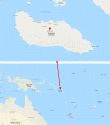
NS0306022a |
86k |
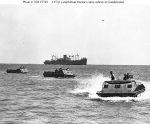
NS100302004 |
109k |
World War II
|

NS0306019 |
111k |
Guadalcanal was built by Kaiser Shipbuilding Co.,
Vancouver, Washington, and launched on Saturday, 5 June 1943. She was sponsored by Mrs. Alvin I. Malstrom. |
Courtesy of the USS Guadalcanal Task Group 22.3 Association,
via Mike Green |

NS0306019a |
104k |

NS0306014 |
66k |
Undated (but probably 1943) photo of a TBM-1C Avenger, part of
Composite Squadron Forty-Two (VC-42), in flight over USS Guadalcanal (CVE-60) in the
Pacific War Zone.
US Navy and Marine Corps Museum/Naval Aviation Museum, Photo No.1996.253.1429. |
Mike Green |
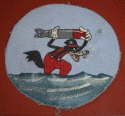
NS0306015 |
52k |
Composite Squadron (VC) 63 patch, Walt Disney design, Big Bad Wolf.
VC-63 was aboard USS Guadalcanal (CVE-60), September–October 1943. |
Tommy Trampp |

NS0306005 |
212k |
USS Guadalcanal (CVE-60). |
EMC(SW) Brian Kroenung |
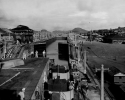
NS0306020 |
92k |
USS Guadalcanal (CVE-60) passing through Panama Canal, canal
lock Pacific side, 26 November 1943.
National Archives photo. |
Courtesy of the
USS Guadalcanal - Task Group 22.3 - Association, via Mike Green |

NS0306020a |
105k |
USS Guadalcanal (CVE-60) entering the Main Cut, Panama Canal,
26 November 1943, on her way to the Atlantic Ocean.
National Archives photo. |
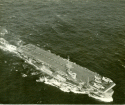
NS0306006 |
165k |
A nice aerial view of USS Guadalcanal (CVE-60) underway, circa
1944. |
EMC(SW) Brian Kroenung |
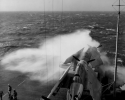
NS0306023 |
71k |
Flying operations were discontinued on USS Guadalcanal (CVE-60)
due to rough weather on 11 January 1944. Heavy weather often made flying conditions difficult during
this cruise.
National Archives and Records Administration (NARA) photo. |
Courtesy of the
USS Guadalcanal - Task Group 22.3 - Association, via Mike Green |

NS0306016 |
73k |
USS Guadalcanal (CVE-60) in Casablanca, French Morocco, for
refueling, 28–30 March 1944.
National Archives photo. |
Courtesy of the
USS Guadalcanal - Task Group 22.3 - Association, via Mike Green |
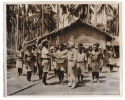
NS0306030 |
136k |
"File No: 213612 Released: April 4, 1944"
"NATIVES PRESENT PLAQUE TO U.S. NAVY FOR ESCORT CARRIER GUADALCANAL"
"Headed by British Resident Administrator Col. Owen C. Noel, a group of natives of the British Solomon
Islands presented to the U.S. Navy for the escort aircraft carrier USS Guadalcanal a plaque
of sandalwood inlaid with native mother of pearl, as an expression of their esteem for the part played
by the U.S. Navy in the expulsion of the Japs from their island homeland. Vice Admiral Aubrey
W. Fitch, USN, of Washington D.C., who is now on duty in the South Pacific, accepted the plaque
on behalf of the warship. The award bears the inscription 'To the United States Navy with Appreciation
from the people of the British Solomon Islands, Guadalcanal, 1943.'"
"Vice Admiral Aubrey W. Fitch, USN, thanks Sergt Major Vouza, Guadalcanal head man, who was decorated
for his participation in the Guadalcanal campaign, for the plaque presented to the Navy for the USS
Guadalcanal"
Duane adds a historical note about Sir
Jacob C. Vouza: "He was captured by the Japanese, tortured, and bayoneted repeatedly and left to
die. He managed to free himself and made it to Marine lines and gave them a 10-minute warning about
the Japanese attack on the Tenaru
River. The Battle of the Tenaru was a clear Marine victory. He passed away in 1984." |
Duane Bass, nky-photos.com |
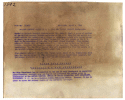
NS0306030a |
84k |
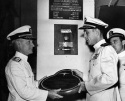
NS0306030b |
884k |
Plaque presented to USS Guadalcanal (CVE-60) from the people
of the British Solomon Islands, and delivered by Rear Admiral Albert C. Read, USN, to Captain Daniel
V. Gallery. Shown, left to right: Rear Admiral Read; Captain Gallery, and Lieutenant
Commander Joseph O. M. Thatcher, MC. Photograph dated 13 May 1944.
U.S. Navy photograph, now in the collections of the National
Archives and Records Administration (NARA), # 80-G-244875. |
NARA |
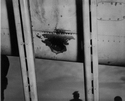
NS0306028 |
56k |
German submarine U-68,
Type IXC, was sunk with machine gun fire, rockets and depth bombs by two TBF/TBM-1C Avengers—LT
S.G. Parsons (plane # 24), and LT H.E. Hoerner (# 22)—and one FM-2 Wildcat—LCDR
Richard K. Gould (# 4)—from VC-58, operating off USS Guadalcanal (CVE-60). Date
was 10 April 1944, position 33°24'N, 18°59'W (mid-Atlantic, northwest of Madeira). Fifty-six
German sailors perished, and a single survivor was rescued by USS Chatelain
(DE-149).
NS0306028: Damage to the underside of the starboard wing of LT(JG) Parsons's
aircraft, caused by U-68's anti-aircraft fire.
NS0306028a: Air flask from one of U-68's torpedoes, in the hangar
bay of Guadalcanal. |
USN |
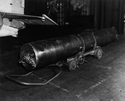
NS0306028a |
123k |

NS0306003 |
51k |
USS Guadalcanal (CVE-60). View from the flight deck, in a steep
turn.
Photo by James Cox Davis, who was aboard at the time of the capture of U-505. |
Mike Davis, for his father James Cox Davis |

NS0306001 |
834k |
USS Guadalcanal leaves Norfolk on her third ASW cruise, 15
May 1944. Photo taken by squadron ZP-14 off the East Coast. Guadalcanal is in camouflage
Measure 32 Design 4A. The vertical colors should be Navy Blue, Haze Blue, Light Blue and Pale Blue.
"The Guadalcanal (CVE-60) operated in the Atlantic and, like other ships of the class
assigned to antisubmarine escort duties, was equipped with a high-frequency direction-finding antenna
on a pole mast forward of the island. She carried the standard class armament of a single 5-inch/38-caliber
dual-purpose gun at the stern, eight twin 40-mm Bofors antiaircraft mounts paired on the gallery deck
at the four corners of the flight deck, and 20 single 20-mm Oerlikons spaced along the gallery deck.
Six Avengers and eight Wildcats are on deck in this May 1944 view."
(Quoted text from the April 2007 issue of Naval History Magazine, US
Naval Institute, via Joe Radigan.) |
USN
Larger copy courtesy of C. Lee Johnson, usndazzle.com,
via
Mike Green |

NS0306024 |
107k |
USS Guadalcanal (CVE-60), Third ASW Cruise, Track Charts (Task
Group 22.3 Report, Enclosure C), 15 May–19 June 1944. |
USN |
Capture of U-505, 4 June 1944
|
See also WWII U-Boats, U-505,
available at NavSource.
Read "Capture
of U-505 on 4 June 1944," available at the Naval
History & Heritage Command website.
|

NS0306035 |
180k |
"Depth charges dropped by U.S. Navy destroyer escorts explode near the German
submarine U-505 in the Atlantic
Ocean on 4 June 1944." |
Bob Canchola, BT, USN (Ret.) |
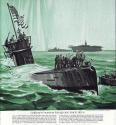
NS0306002a |
237k |
"Gallery's hunters bring one back alive."
Reprint of an original painting from the Librascope collection depicting the boarding of U-505. |
Robert Hurst |

NS0306002b |
82k |
"Part III, The Capture" and "Conclusion" as reported by CAPT D. V. Gallery. |
Naval History & Heritage Command |
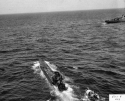
NS0306002h |
414k |
Aerial view of one of the boarding parties as they came alongside of sub.
Task Group 22.3 Report, Enclosure G, Photograph 429. |
Bob Canchola, BT, USN (Ret.) |
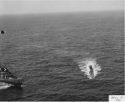
NS0306002k |
62k |
Aerial view of one of the boarding parties, showing USS Chatelain
(DE-149) closing in on German sub U-505.
Task Group 22.3 Report, Enclosure G, Photograph 430. |
USN |
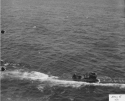
NS0306002l |
68k |
Aerial view of German submarine U-505.
Task Group 22.3 Report, Enclosure G, Photograph 431. |
USN |
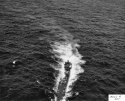
NS0306002s |
437k |
Aerial view of German submarine U-505,
just after crew abandoned ship.
Task Group 22.3 Report, Enclosure G, Photograph 432. |
Bob Canchola, BT, USN (Ret.) |
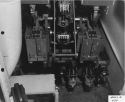
NS0306002u |
70k |
"Radio Gear aboard German sub." (Actually, this is the main battery switch
in the E-motor room.)
Task Group 22.3 Report, Enclosure G, Photograph 434. |
USN |
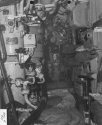
NS0306002v |
85k |
"View in control room of German sub."
Task Group 22.3 Report, Enclosure G, Photograph 435. |
USN |
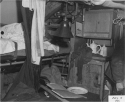
NS0306002w |
83k |
"View in Captain's cabin aboard German sub #505."
Task Group 22.3 Report, Enclosure G, Photograph 436. |
USN |
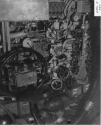
NS0306002x |
82k |
"View in control room of German sub."
Task Group 22.3 Report, Enclosure G, Photograph 437. |
USN |
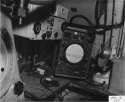
NS0306002y |
73k |
"Detection gear aboard German sub."
Task Group 22.3 Report, Enclosure G, Photograph 438. |
USN |
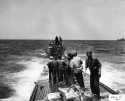
NS0306002r |
319k |
View from the bow of U-505,
showing salvage crew.
Task Group 22.3 Report, Enclosure G, Photograph 439. |
Bob Canchola, BT, USN (Ret.) |
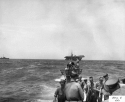
NS0306002e |
238k |
View from the bow of U-505,
showing salvage crew on the sub's deck and USS Guadalcanal (CVE-60) in the background.
Task Group 22.3 Report, Enclosure G, Photograph 440. |
Bob Canchola, BT, USN (Ret.) |
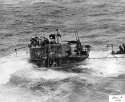
NS0306002q |
413k |
Port side of conning tower of German sub U-505.
Task Group 22.3 Report, Enclosure G, Photograph 442. |
Bob Canchola, BT, USN (Ret.) |
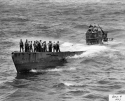
NS0306002p |
401k |
View from fantail of ship showing salvage crew aboard German sub U-505.
Task Group 22.3 Report, Enclosure G, Photograph 443. |
Bob Canchola, BT, USN (Ret.) |

NS0306002p1 |
226k |
Another view, as above. |
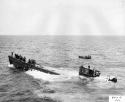
NS0306002o |
308k |
Salvage crew aboard German sub U-505.
Task Group 22.3 Report, Enclosure G, Photograph 444. |
Bob Canchola, BT, USN (Ret.) |
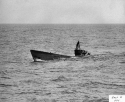
NS0306002n |
403k |
U.S. Colors flying over captured German submarine U-505.
Task Group 22.3 Report, Enclosure G, Photograph 446. |
Bob Canchola, BT, USN (Ret.) |
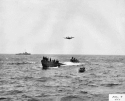
NS0306002m |
237k |
A TBM-1C Avenger from Composite Squadron (VC) 8, USS Guadalcanal
(CVE-60), circling captured German submarine U-505.
Task Group 22.3 Report, Enclosure G, Photograph 447. |
Bob Canchola, BT, USN (Ret.) |
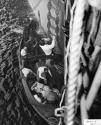
NS0306002i |
349k |
German sub survivors coming aboard.
Task Group 22.3 Report, Enclosure G, Photograph 450. |
Bob Canchola, BT, USN (Ret.) |
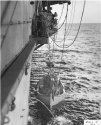
NS0306002g |
763k |
Wounded German sub survivor being hoisted aboard in stretcher.
Task Group 22.3 Report, Enclosure G, Photograph 452. |
Bob Canchola, BT, USN (Ret.) |
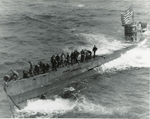
NS0850502 |
561k |
A boarding party from USS Pillsbury
(DE-133) works to secure a tow line to the newly captured German submarine U-505,
4 June 1944. Note the large U.S. flag flying from the periscope. While U-505 has been on exhibit
at the Museum of Science and Industry in Chicago
since 1954, this periscope has been missing from the submarine since the Navy removed it for testing
after World War II. The two were reunited when the periscope was discovered during the demolition of
the Navy's old Arctic Submarine Laboratory in Point Loma, Calif., and it was sent to the museum. It
would be reinstalled during the U-boat's extensive restoration.
Task Group 22.3 Report, Enclosure G, Photograph 455.
National Archives and Records Administration
(NARA), photo # 80-G-49172. |
USN |
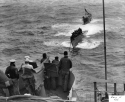
NS0306002j |
378k |
Salvage crew hauling tow line aboard sub.
Task Group 22.3 Report, Enclosure G, Photograph 456. |
Bob Canchola, BT, USN (Ret.) |
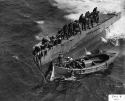
NS0306002t |
388k |
Motor whale boat fouled on tow line.
Task Group 22.3 Report, Enclosure G, Photograph 457. |
Bob Canchola, BT, USN (Ret.) |

NS0306039 |
303k |
USS Pillsbury
(DE-133) tied up to German submarine U-505
after a U.S. Navy boarding party had captured the
enemy submarine, 4 June 1944. Note the heavily loaded whaleboat in the foreground. Photographed from
USS Guadalcanal (CVE-60).
Official U.S. Navy photograph, now in the collections of the National
Archives and Records Administration, # 80-G-324310. |
Bob Canchola, BT, USN (Ret.) |
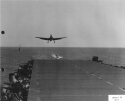
NS0306002z |
458k |
Recovering TBM Avenger with sub in tow.
Task Group 22.3 Report, Enclosure G, Photograph 461. |
Bob Canchola, BT, USN (Ret.) |
>
NS0306002d |
434k |
A TBM Avenger recovering aboard USS Guadalcanal (CVE-60),
while she was towing U-505 on 4
June 1944. The escort carrier kept up flight operations for days while the captured submarine was being
towed toward Bermuda until the fleet tug USS Abnaki
(ATF-96) rendezvoused with the task group and took over towing duties. The group arrived in Bermuda
19 June 1944.
Source: United States National Archives and Records Administration,
photo No. 80-G-49174. |
Mike Green |
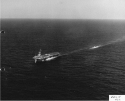
NS0306002ca |
590k |
Aerial view off port bow showing sub in tow.
Task Group 22.3 Report, Enclosure G, Photograph 462. |
Bob Canchola, BT, USN (Ret.) |
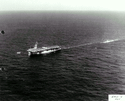
NS0306002c |
184k |
USS Guadalcanal (CVE-60) conducting flight operations while
towing U-505 on 4 June 1944. The captured submarine
was being towed toward Bermuda until the fleet tug USS Abnaki
(ATF-96) rendezvoused with the task group and took over towing duties. The group arrived in Bermuda
19 June 1944.
Task Group 22.3 Report, Enclosure G, Photograph 464.
Source: United States National Archives and Records Administration
(NARA), photo No. unknown. |
Mike Green |
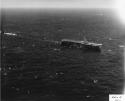
NS0306002cb |
629k |
Aerial view off starboard bow showing sub in tow.
Task Group 22.3 Report, Enclosure G, Photograph 465. |
Bob Canchola, BT, USN (Ret.) |

NS0306002cc |
19k |
USS Guadalcanal (CVE-60) with U-505
under tow. |
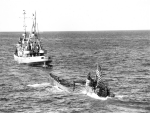
NS093909614 |
1.31M |
USS Abnaki
(ATF-96) towing captured German sub.
Task Group 22.3 Report, Enclosure G, Photograph 468. |
Joseph Colombara, USS Abnaki |
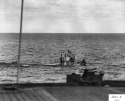
NS0306029 |
321k |
U.S. Ensign over Nazi Ensign on sub.
Task Group 22.3 Report, Enclosure G, Photograph 469. |
Bob Canchola, BT, USN (Ret.) |
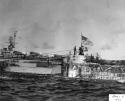
NS0306029a |
287k |
Captured Nazi sub conning tower with US & Nazi sub [sic].
Task Group 22.3 Report, Enclosure G, Photograph 470. |
Bob Canchola, BT, USN (Ret.) |

NS0306029a1 |
384k |
The U.S. flag flies over the German naval ensign, with U-505's
periscope serving as the flagstaff. Taken soon after the submarine's capture (photo is dated 6 June
1944, but appears to have been taken two days earlier). Note the hoses running from U-505's
fairwater, indicating that she is still being dewatered. USS Guadalcanal (CVE-60) is
in the background, with several TBM Avenger bombers parked on her flight deck.
Official U.S. Navy Photograph, now in the collections
of the National Archives and Records Administration
(NARA), # 80-G-324800. |
Bob Canchola, BT, USN (Ret.) |
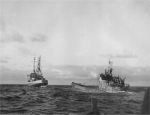
NS093909616 |
67k |
USS Abnaki
towing captured Nazi sub #505.
Task Group 22.3 Report, Enclosure G, Photograph 471. |
Joseph Colombara, USS Abnaki |

NS0306002 |
421k |
USS Guadalcanal (CVE-60) with captured German submarine U-505
alongside, off the coast of Africa, 4 June 1944.
National Archives and Records Administration (NARA) photo,
# 80-G-49170.
Task Group 22.3 Report, Enclosure G, Photograph 472. |
US Navy Photo, thanks to Jim Kurrasch, Battleship
Iowa, Pacific Battleship Center
Bob Canchola, BT, USN (Ret.) |
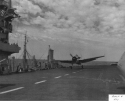
NS0306029b |
128k |
Landing TBM while refueling from tanker U.S.S. Kennebec
[(AO-36)].
Task Group 22.3 Report, Enclosure G, Photograph 477. |
Bob Canchola, BT, USN (Ret.) |
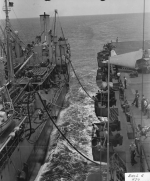
NS091903624 |
281k |
View from bridge of refueling from tanker U.S.S. Kennebec
[(AO-36)].
Task Group 22.3 Report, Enclosure G, Photograph 479. |
John Chiquoine |
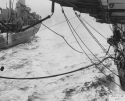
NS0306029c |
222k |
View from #1 whale boat of refueling operations [from] U.S.S. Kennebec
[(AO-36)].
Task Group 22.3 Report, Enclosure G, Photograph 481. |
USN |
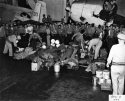
NS0306029d |
379k |
Gear stacked on hangar deck that was brought over from sub.
Task Group 22.3 Report, Enclosure G, Photograph 494. |
Bob Canchola, BT, USN (Ret.) |
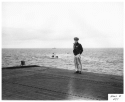
NS0306029e |
128k |
Captain Gallery
on flight deck with captured sub in background.
Task Group 22.3 Report, Enclosure G, Photograph 497. |
Bob Canchola, BT, USN (Ret.) |
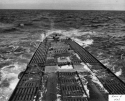
NS0306029f |
382k |
View from 35mm gun mount showing stern of U-505.
Task Group 22.3 Report, Enclosure G, Photograph 498. |
Bob Canchola, BT, USN (Ret.) |
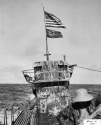
NS0306029g |
281k |
View of US and German colors flying over conning tower of U-505.
Task Group 22.3 Report, Enclosure G, Photograph 499. |
Bob Canchola, BT, USN (Ret.) |
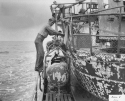
NS0306029h |
320k |
View of forward end of damaged torpedo on U-505.
Task Group 22.3 Report, Enclosure G, Photograph 500. |
Bob Canchola, BT, USN (Ret.) |
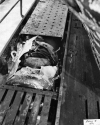
NS0306029i |
369k |
Damaged torpedo and case in cradle on U-505.
Task Group 22.3 Report, Enclosure G, Photograph 501. |
Bob Canchola, BT, USN (Ret.) |
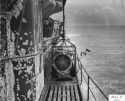
NS0306029j |
192k |
View of after end of damaged war head on U-505.
Task Group 22.3 Report, Enclosure G, Photograph 502. |
USN |
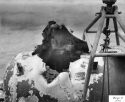
NS0306029k |
312k |
Close up view of damaged torpedo from U-505.
Task Group 22.3 Report, Enclosure G, Photograph 503. |
Bob Canchola, BT, USN (Ret.) |
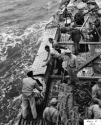
NS0306029l |
435k |
Preparing to jettison damaged torpedo from U-505.
Task Group 22.3 Report, Enclosure G, Photograph 504. |
Bob Canchola, BT, USN (Ret.) |
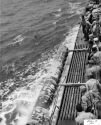
NS0306029m |
375k |
Torpedo being dumped over side of U-505.
War head was damaged by depth charge.
Task Group 22.3 Report, Enclosure G, Photograph 505. |
Bob Canchola, BT, USN (Ret.) |
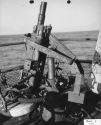
NS0306029n |
213k |
20mm AA gun mount on U-505.
Task Group 22.3 Report, Enclosure G, Photograph 506. |
USN |
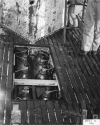
NS0306029o |
323k |
"Flask as in rack aft of conning tower on U-505".
Task Group 22.3 Report, Enclosure G, Photograph 507. |
USN |
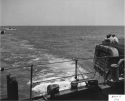
NS0306029p |
185k |
"Towing bridle from starboard side of fantail with sub in background."
Task Group 22.3 Report, Enclosure G, Photograph 509. |
USN |
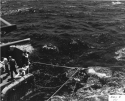
NS0306029q |
288k |
"Towing bridle from port side of fantail."
Task Group 22.3 Report, Enclosure G, Photograph 511. |
USN |

NS0306029r |
1.51M |
"Captain Gallery
on bridge of 'Junior', U-505."
Task Group 22.3 Report, Enclosure G, Photograph 514.
National Archives and Records Administration
(NARA) photo, # 80-G-49176. |
Bob Canchola, BT, USN (Ret.) |
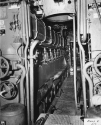
NS0306029t |
244k |
"Diesel engine room of 'Junior', U-505."
Task Group 22.3 Report, Enclosure G, Photograph 516. |
USN |
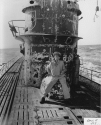
NS0306029u |
205k |
"Captain Gallery
in front of Conning tower of 'Junior', U-505."
Task Group 22.3 Report, Enclosure G, Photograph 517. |
Bob Canchola, BT, USN (Ret.) |
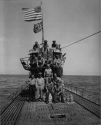
NS0306029v |
125k |
"Salvage party in front of Conning tower of 'Junior', U-505."
Task Group 22.3 Report, Enclosure G, Photograph 518. |
Bob Canchola, BT, USN (Ret.) |
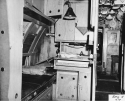
NS0306029w |
153k |
"Doctors compartment on U-505."
Task Group 22.3 Report, Enclosure G, Photograph 519. |
USN |
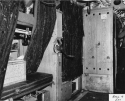
NS0306029x |
169k |
"Petty officer quarters."
Task Group 22.3 Report, Enclosure G, Photograph 520. |
USN |
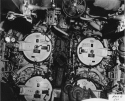
NS0306029y |
259k |
"Forward torpedo tubes."
Task Group 22.3 Report, Enclosure G, Photograph 521. |
USN |
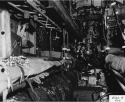
NS0306029z |
216k |
"Crew quarters in after torpedo room of U-505."
Task Group 22.3 Report, Enclosure G, Photograph 522. |
USN |
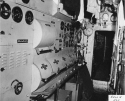
NS0306031 |
202k |
"Control panel for electric motors aboard U-505."
Task Group 22.3 Report, Enclosure G, Photograph 523. |
USN |
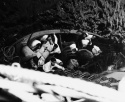
NS0306002f |
431k |
German crewmen from the captured submarine, U-505,
ascend a Jacobs ladder to board USS Guadalcanal (CVE-60). With them, they bring the body
of the only casualty, a German sailor killed by strafing when he attempted to man a gun on board the
U-boat, 4 June 1944.
National Archives and Records Administration
(NARA) photo, # 80-G-49173. |
NARA |
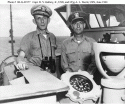
NS0306012 |
57k |
Captain Daniel V. Gallery, Jr., USN (left) and Lieutenant Junior Grade Albert
L. David, USN photographed aboard USS Guadalcanal (CVE-60) in June 1944. On 4 June 1944
LT(JG) David led the boarding party that took control of the German submarine U-505 after it
was forced to surface by Guadalcanal's task force. This capture of an enemy warship
on the high seas was the first by the U.S. Navy since 1815. Albert David, who died on 17 September
1945, was posthumously awarded the Medal of Honor for his leadership and bravery during this action.
USS Gallery (FFG-26) was named
after RADM Daniel Vincent Gallery and his brothers, RADM William Onahan Gallery and RADM Philip Daly
Gallery. USS Albert David (DE-1050,
later FF-1050) was named after LT Albert Leroy David.
Official U.S. Navy Photograph, now in the collections of the National Archives (# 80-G-49177). |
Naval History & Heritage Command |

NS0306013 |
82k |
Halftone reproduction of a photograph taken soon after U-505's capture
(4 June 1944), copied from the "USS Guadalcanal (CVE-60) Memory Log, " page 28.
U.S. Naval Officers shown on the submarine's conning tower are, from left to right: Commander Earl
Trosino, USNR; Captain Daniel V. Gallery, Jr., USN, Commanding Officer, USS Guadalcanal;
and Lieutenant Junior Grade Albert L. David, USN, who was posthumously awarded the Medal of Honor for
leading the boarding party that captured the submarine and carried out initial salvage operations.
Note the United States flag flying above the German Navy ensign. U-505 was the first enemy
warship captured on the high seas by the U.S. Navy since 1815.
Courtesy of the Naval Historical Foundation, Washington, DC.
Naval History & Heritage Command photo (# NH 105857). |
Naval History & Heritage Command |
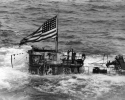
NS0306013a |
244k |
U.S. Colors fly over captured U-505.
Note U-505's emblem, a seashell, painted on the sail. |
Bob Canchola, BT, USN (Ret.) |

NS0306032 |
185k |
Memo from CAPT Gallery
to all hands of Task Group 22.3, 14 June 1944. "The operations which we have conducted since 1100 June
4th have been classified as top secret." |
USN |

NS0306033 |
82k |
The captured U-505
arrived in Bermuda under tow on 19 June 1944, and remained there, shrouded in secrecy, for the remainder
of the war. Kenneth Knowles of the U.S. Submarine Tracking Room; Francis Low, the outgoing Chief of
Staff, Tenth Fleet, and seven others flew to Bermuda to inspect the boat and to interrogate the prisoners.
This photo shows the inspection team's flying-boat arriving in the island. |
USN |

NS0306033a |
76k |
USS Abnaki
(ATF-96), left; captured German submarine U-505,
center; and covered lighter YFN-275,
moored at Bermuda, 19–29 June 1944. |
USN |

NS0306033b |
85k |
View of the stern showing the open aft torpedo loading hatch. |
USN |

NS0306033c |
69k |
View of the conning tower from USS Abnaki
(ATF-96). |
USN |

NS0306033d |
69k |
U-505's
conning tower emblems are covered with tarps, damage from 3"/50 caliber gunfire is apparent. |
USN |

NS0306033e |
65k |
View of the bridge showing the circular dipole antenna for the radar warning
receiver. Note covered lighter YFN-275
to starboard of U-505. |
USN |

NS0306034 |
200k |
German prisoners of war from the captured submarine U-505
exercise on the forward elevator of the U.S. Navy escort carrier USS Guadalcanal (CVE-60),
in June 1944. Note the General Motors TBM-1C Avengers of Composite Squadron (VC) 8 parked on
the bow.
U.S. Navy photo from the Guadalcanal
World War II Cruise Book. |
Robert Hurst |
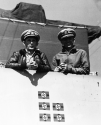
NS0306035 |
574k |
Captain Daniel V.
Gallery and Commander Johnson shown aboard USS Guadalcanal (CVE-60), 6 July 1944.
Note, the five Nazi flags
National Archives and Records Administration
(NARA) photo, # 80-G-383997. |
Bob Canchola, BT, USN (Ret.) |
|
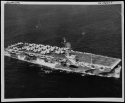
NS0306004 |
546k |
USS Guadalcanal (CVE-60) photographed from a ZP-24 blimp while
steaming off Hampton Roads, Virginia on 28 September 1944. Her reported position was 36-56N, 74-50W,
course 095. Planes parked on her flight deck include twelve TBM/TBF Avenger torpedo bombers
and nine FM/F4F Wildcat fighters. Guadalcanal is painted in what appears to be
a modified version of Camouflage Measure 32, Design 4A.
Official U.S. Navy Photograph, from the collections
of the Naval History and Heritage Command,
# NH 106567. |
Naval History & Heritage Command,
via Bob Canchola |
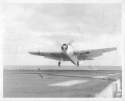
NS0306011 |
77k |
USS Guadalcanal (CVE-60) photo # 846, 11 October 1944, 2,600th
landing, Composite Squadron 69 (VC-69). |
Harold Ryan |
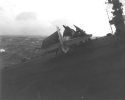
NS0306017 |
145k |
Gale and hurricane weather, 17 October 1944. Seas were exceedingly high
in the morning and increased to mountainous in the afternoon. The winds averaged 48 knots, but as
high as 70 knots were recorded. Barometer lowest reading was 28.61. The Guadalcanal
rolled and pitched constantly, steering was difficult, engines were used to help steer the course.
Source: National Archive Photo; Courtesy of Task Group 22.3 Association. |
Courtesy of the
USS Guadalcanal - Task Group 22.3 - Association, via Mike Green |
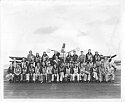
NS0306018 |
144k |
Composite Squadron (VC) 69 officers, USS Guadalcanal
(CVE-60), November 1, 1944.
(Larger images available on request.) |
Harold Ryan |
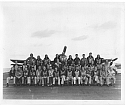
NS0306018a |
137k |
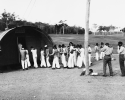
NS0306037 |
753k |
Training activities for personnel of USS Guadalcanal (CVE-60)
at Guantánamo Bay, Cuba. Crew is entering the gas chamber, 28 January 1945.
National Archives and Records Administration
(NARA) photo, # 80-G-383976. |
NARA |

NS0306040 |
1001k |
Crash of an F4U Corsair into catwalk aboard USS Guadalcanal
(CVE-60), 5 April 1945.
National Archives and Records Administration
(NARA) photo, # 80-G-383978. |
NARA |

NS0306007 |
1.51M |
Image from the USS Guadalcanal Memory Log (Cruise Book.) Taken at
Mayport, Fla., 20 April 1945. |
EMC(SW) Brian Kroenung
BT Bob Canchola |

NS0306007a |
820k |
Similar to the photo above, but clearer. Guadalcanal
is painted in Measure 32 Design 4A camouflage scheme.
National Archives and Records Administration
(NARA) photo, # 80-G-383899. |
Courtesy of C. Lee Johnson, usndazzle.com,
via Mike Green |
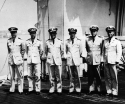
NS0306025 |
1.39M |
Commanding Officers of various ships in Task Group that captured U-boat, U-505.
Shown on flight deck of USS Guadalcanal (CVE-60). Left to right: Lieutenant Commander
(later Admiral) Means F. Johnston Jr., USS Flaherty
(DE-135); Lieutenant Commander (later Captain) Edwin H. Headland, USS Pope
(DE-134); Commander (later Captain) Frederick S. Hall, Commander, Escort Division 4; Captain (later
Rear Admiral) Daniel V. Gallery, Guadalcanal;
Commander Dudley S. Knox, USS Chatelain
(DE-149); and Lieutenant Commander (later Rear Admiral) George W. Cassleman, USS Pillsbury
(DE-133). Photo dated 16 May 1945.
National Archives and Records Administration
(NARA), photo # 80-G-49185. |
NARA |

NS0306025a |
791k |
Captain Daniel V.
Gallery presenting a Nazi submarine flag, captured from German U-Boat, U-505,
to Admiral Jonas H. Ingram at the Navy Department
in Washington, D.C., 16 May 1945. Secretary of the Navy James
V. Forrestal is behind Admiral Ingram.
National Archives and Records Administration
(NARA), photo # 80-G-49191. |
NARA |

NS0306009 |
63k |
Commander Joy Bright Hancock, USNR, is met by Captain B.C. McCaffree, USN,
Commanding Officer, USS Guadalcanal (CVE-60), as she comes aboard his ship, 19 July 1945.
Official U.S. Navy Photograph, now in the collections of the National Archives (# 80-G-383994).
Joy Bright was born in Wildwood, New Jersey, on 4 May 1898. During World War I, after attending
business school in Philadelphia, Pennsylvania, she enlisted in the Navy as a Yeoman (F), serving at
Camden, New Jersey and at the Naval Air Station, Cape May. Following the war, she married Lieutenant
Charles Gray Little, who was killed in the crash of the airship ZR-2 in 1921. A year later,
she obtained employment with the Bureau of Aeronautics, where her duties included editing the Bureau's
"News Letter," which later evolved into the magazine "Naval Aviation News." In 1924,
she left the Bureau to marry Lieutenant Commander Lewis Hancock, Jr., who lost his life when USS Shenandoah
(ZR-1) crashed in September 1925—subsequently, she sponsored USS Lewis
Hancock (DD-675), named after her late husband.
Joy Bright Hancock returned to the Bureau after attending Foreign Service School and obtaining a
private pilot's license. For more than a decade before World War II and into the first year of that
conflict, she was responsible for the Bureau's public affairs activities. In October 1942, she was
commissioned a Lieutenant in the new Women's Reserve (WAVES). She initially served as WAVES representative
in the Bureau of Aeronautics and later in a similar position for the Deputy Chief of Naval Operations
(Air), rising to the rank of Commander by the end of the War.
In February 1946, Commander Hancock became the Assistant Director (Plans) of the Women's Reserve
and was promoted to WAVES' Director, with the rank of Captain, in July of that year. She guided the
WAVES through the difficult years of Naval contraction in the later 1940s and the expansion of the
early 1950s, a period that also saw the Navy's women achieve status as part of the Regular Navy. Captain
Hancock retired from active duty in June 1953. The next year, she married Vice Admiral Ralph A. Ofstie
and accompanied him on his 1955–56 tour as Commander, Sixth Fleet. Following her husband's death
in late 1956, she lived in the Washington, D.C., area and in the Virgin Islands. She died on 20 August
1986. |
NHC |
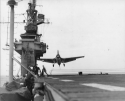
NS0306027 |
162k |
Avenger flies over wires and skips barriers, crashing into
the island during carrier qualifications aboard USS Guadalcanal (CVE-60), 21 August 1945. |
Gerd Matthes, Germany |

NS0306027a |
109k |
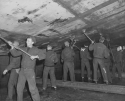
NS0306026 |
217k |
Sailors cleaning USS Guadalcanal's hull in dry dock, 15 December
1945. |
Gerd Matthes, Germany |
Post-war
|

NS0306038 |
123k |
In 1964 Oberleutnant zur See (R)—Lieutenant-Senior (Reserve)—Harald
Lange met in Chicago with Captain (later Rear Admiral) Daniel
Gallery, to commemorate the 20th anniversary of the capture of U-505.
On that occasion Captain Gallery returned the submarine captain's binoculars to Captain Lange. |
Bob Canchola |
Miscellany
|

NS0306008 |
159k |
This 8-foot (2.44 meters) model of USS Guadalcanal (CVE-60)
was donated to the Intrepid
Museum in NYC and will go on display in 2008. |
Tom Dunham |
Ex-USS Guadalcanal
|
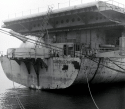
NS0306021 |
222k |
Stern view of ex-USS Guadalcanal (CVE-60) in mothballs, February
1950. The ship was part of the Atlantic Reserve Fleet and was moored at Bayonne, New Jersey.
LIFE Magazine Archives, Herbert Gehr photographer, shared by
Peter DeForest (for educational and non-commercial use only). |
Mike Green |
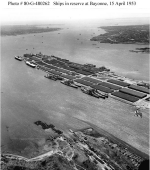
NS015535 |
112k |
Bayonne Naval Supply Depot, New Jersey. Photographed on 15 April 1953 with
ships in reserve. The two large ships at right on the near side of the peninsula are Alaska
(CB-1) and Guam (CB-2).
The next two ships astern are North Carolina
(BB-55) and Washington (BB-56).
Further astern are (from outboard to inboard) Fargo
(CL-106), Albemarle (AV-5) and
Wakefield (AP-21). The carriers
Enterprise (CVA-6) and Franklin
(CVA-13) are at the far left. Also present are the escort carriers Card
(CVE-11), Croatan (CVE-25), Mission Bay (CVE-59)
and Guadalcanal (CVE-60) along with the cruisers Providence
(CL-82), Little Rock (CL-92),
Spokane (CLAA-120) and Fresno
(CLAA-121). One of the two CLAAs is tied up outboard of the Alaskas.
National Archives and Records Administration
(NARA) photo, # 80-G-480262. |
Via Robert Hurst |

NS0306010 |
341k |
"Ex-Navy Carriers [Guadalcanal and Mission
Bay] May Go To Japan for Breaking Up." |
Ron Reeves |
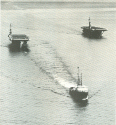
NS0305902 |
220k |
Stripped and powerless, the veteran WWII escort carriers Guadalcanal
and Mission Bay take a last voyage to a Japanese scrapyard under the charge of the Dutch
tug Elbe. |
EMC(SW) Brian Kroenung |
For more photos and information about this ship, see:
|























































































































